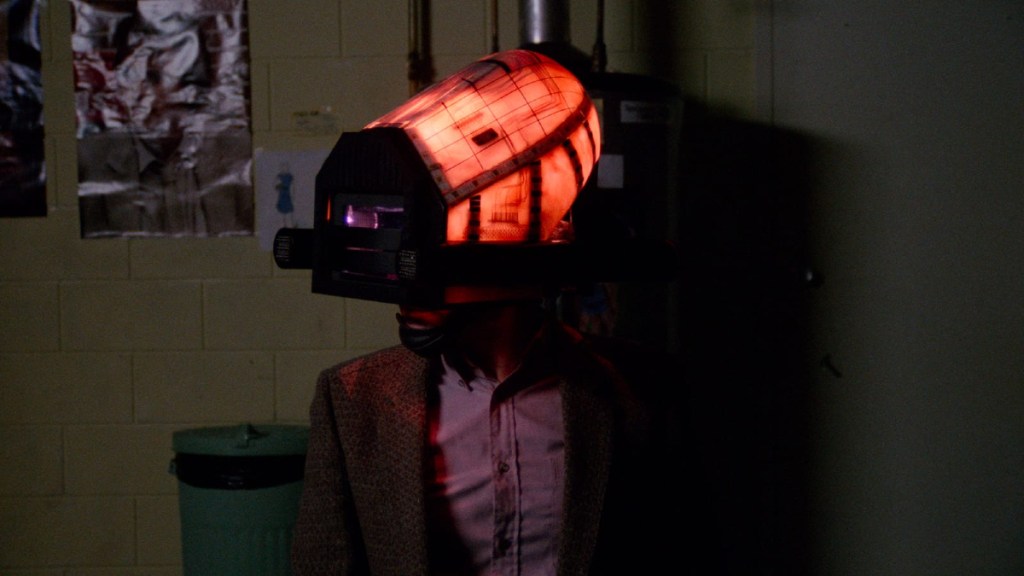These days, whenever James Woods‘ name trends on social media, it’s usually because he’s either posted something inflammatory from a right-wing, anti-government, “anti-woke” perspective, or been accused of skeezy behavior and appetites. It’s sometimes hard to recall that, unlike his fellow Twitter Troll travelers like Kevin Sorbo, Woods was consistently acclaimed as one of the best actors of the ’80s. He was also acclaimed as one of the smartest, albeit mainly by his own publicists. Nonetheless, when he and Sean Young broke up, it’s telling that the public at the time mostly believed she was the crazy one. Watching Woods in David Cronenberg‘s 1983 film Videodrome today, one can’t help being struck not just by the way the movie predicted multimedia obsessions, but also the actor’s own career trajectory.
Into the Woods…
Woods plays Max Renn — his name a reversal of Cronenberg’s favorite motorcycle, the Rennmax — a TV station owner who’s always on the lookout for the most extreme content. He says it’s a way to stand out and get ratings, but there’s plenty to suggest that Renn himself has the deviant appetites he ascribes to his audience, always looking for more intense spank material. When his tech-savvy partner (Peter Dvorsky) discovers a scrambled feed of literal torture porn (real-life torture for titillation, as opposed to an Eli Roth movie), Renn craves more. He must get those broadcast rights for himself, but he also can’t get enough of watching it. In what may be a George Romero-related in-joke, the signal appears to emanate from Pittsburgh.

Unfortunately for Max, this particular porn addiction has more than just behavioral side effects. The signal itself creates a brain tumor that induces hallucinations. Some people, like the pseudonymous Professor O’Blivion (Jack Creley), think they might be beneficial. What soon becomes clear, however, is that the people behind the signal have an agenda, and a big part of it involves making viewers more susceptible to commands. Max becomes romantically involved with a masochist (Deborah Harry) who may not actually exist, and envisions himself as a VCR made of flesh, as Betamax tapes seemingly inserted into his newly grown stomach-vagina order him to kill. With this film, Cronenberg has arguably literalized the term “mindf**k” more viscerally than anything short of illegal porn.
Can You Stomach It?
This was a lot to take in as an ’80s teen merely perusing the horror aisles at the local video store, and renting everything that sounded interesting. Cronenberg, in the most simplistic terms, is known for “body horror,” but for the most part, his films are far more cerebral than grotesque. He can do show-stopping gore, but only when appropriate — if one doesn’t engage his story on an intellectual level, the viscera alone may not make a lot of sense. (Anyone renting Scanners purely for exploding heads may be quite disappointed after the initial effect.) The home VCR at a consumer level was relatively new when Videodrome came out; Cronenberg, via the writings of Canadian philosopher Marshall McLuhan, understood its capacity for influence and psychological addiction very early on.
McLuhan more or less predicted the World Wide Web; Videodrome, one could argue, predicted something like the troll factories and bots that feed on users’ addiction to outrage and skew them towards particular behavorial and voting patterns. It’s no small irony that Woods himself appears to have gotten so hooked on the particular dopamine hit of hate-retweets. Nor that the conspirators in Videodrome claim to be motivated by America getting soft (today, it’d be “woke”) relative to the supposedly “tough” rest of the world.
Actually, It’s About Ethics in Cable Programming
TV typically uses the power of persuasion to induce buying and consumption; the Internet, like Videodrome’s villains, has shown more of a capacity to actively influence ideologies. The alt-right recruitment of gamers, manipulating fears that feminists were going to ruin the sexpot characters in their favorite games, is but one notable real-world example. Insert your own favorite hacked/rigged/influenced election theory for a chaser. That one major character in Videodrome seems to only exist on videotape, while another may be entirely hallucinated, feel like predictions of catfishing and the precarious nature of online avatars. Cronenberg has said he has no particular interest in being a prophet, but he’s observant enough about human behavior and fear that his analysis can take on a timeless quality.

Videodrome’s 4K set, like most recent Criterion 4Ks, includes their 2010 Blu-ray with all its supplements, and a new 4K disc that includes both existing commentary tracks recorded in 2004, a date that notably precedes Woods’ most public descent into social media madness. One features stars Woods and Harry; the other, Cronenberg and cinematographer Mark Irwin. For the most part, they all sound recorded separately, though Cronenberg and Irwin do interact once. Woods comes off charming, literate, and smart, recalling a lot of the production process, and referencing other cultural touchstones and trends the movie reminds him of. Harry mostly focuses on her own acting process and insecurities at the time — a pop music icon, she was nonetheless an inexperienced actress, though a casual viewer would never know it.
Old Print or New Flesh?
Cronenberg and Irwin talk about the journey of making the movie without any idea how to end it, and on a deadline to finish by the end of the year or lose their tax funds. That’s right; in Canada, the government funded Cronenberg films. It’s hard to imagine half the population of the U.S. not losing it to hear that any movie got our tax dollars, let alone one with stomach vaginas.

Between the 4K and the Blu-ray, the consumer gets two alternative ways to watch. The Blu-ray, with brighter colors and more grain, feels like an old movie, and looks like a great vintage print hauled out of storage, like you’d see at a rep house. The 4K, on the other hand, feels like a new movie — its color-correction really gives it that cold, clinical feel that so much of Cronenberg’s work embodies. While some of the makeup effects are outstanding and inventive, there’s one involving a prosthetic hand that’s obviously not real, but features enough moving parts to make it creepy anyway.
Other extras on the disc include a montage of on-set photos, a featurette about the makeup, and an old horror director’s forum, as then-documentarian Mick Garris hosts John Landis, John Carpenter, and Cronenberg. Considering what disc this is on, it’s no surprise Cronenberg comes across as the smartest guy in the room; Landis keeps trying to needle Carpenter, who even as a young man feels like an old cuss who’d just as soon have everyone get off his lawn.
Tumor Signal Not Included
Full-length versions of the Videodrome torture footage (staged IRL, obviously) and the pornographic samurai TV show are included with optional commentary, as well as tests of the VR helmet effects (from the days before VR helmets actually existed). It may not surprise anyone to learn that Woods was paranoid about the device possibly electrocuting him.

An older-making of featurette and the original trailers prove fascinating — the trailers are pretty good teasers even by today’s standards, and must have been baffling in an era where excessive narration was the norm.
Final Verdict:
As always, it may feel a little rough buying the 4K for anyone who already owns the included Blu-ray, but it really is a thoroughly different transfer with a different effect. Considering how comprehensive the extras always were, anyone owning the Blu probably couldn’t have imagined anything more might get added. If that sounds like you, hesitation understood. If you don’t own it yet, though, it’s a must-buy. Great movie, great package, and prophetic social commentary that holds up arguably even better now. To call it “horror for grown-ups” isn’t condescension — it takes a certain amount of life experience and social trend observation to really enjoy Videodrome for what it is.
SCORE: 9/10
As ComingSoon’s review policy explains, a score of 9 equates to “Excellent.” Entertainment that reaches this level is at the top of its type. The gold standard that every creator aims to reach.
The Criterion Collection 4K edition of Videodrome is now available to purchase on disc.










